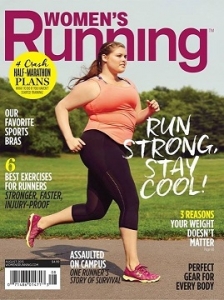 When I read the headline, “Magazine puts a Plus Size Model on the Cover and Twitter Freaks out”, my first reaction was one of frustration. Why, I thought, is the world so irritated by larger bodies? What is it about plus size models that people react so strongly to? Why can’t plus size models be shown running on the cover of a runner’s magazine? Would a plus size male model have caused Twitter to “freak out”?
When I read the headline, “Magazine puts a Plus Size Model on the Cover and Twitter Freaks out”, my first reaction was one of frustration. Why, I thought, is the world so irritated by larger bodies? What is it about plus size models that people react so strongly to? Why can’t plus size models be shown running on the cover of a runner’s magazine? Would a plus size male model have caused Twitter to “freak out”?
Then I went on to read how Twitter was freaking out.
“I almost cried when I opened my mailbox and saw a thick girl like me on the cover. Thank you @women’srunning!”
“@women’srunning gave me chills because this is incredibly awesome. THANK YOU, said every girl and woman in america!”
“@Women’srunning Beautiful! Thank you for this wonderful cover with a lovely woman runner that shows all sizes run! Thank you! Thank you!”
“@Woman’srunning Makes me wonder if I can run…? Maybe it’s time to stop worrying about what others think and just do it.”
“This is proving that runners come in all shapes and sizes. Smashing the stereotype! Well done @Woman’srunning!”
Contempt prior to investigation gets me every time. My assumption that the general population would react with negativity is telling, though, isn’t it? What a wonderful surprise to be so wrong.
Women’s Running didn’t stop there…they also printed articles geared toward runners of all sizes. This fact was not lost on readers. One woman made this comment in regards to the articles entitled, “Three Reasons why your Weight Doesn’t Matter” and “Perfect Gear for Every Body”:
“What’s particularly nice about this is that it isn’t to accompany a special piece on running for weight loss or on ‘plus size’ runners. It’s just straight up a picture of another model on the cover. It’s not to promote a diet regime or anything like that. Which, to me, makes it even more fantastic.”
It’s not an article about, “10 Ways Running can Burn Away your Fat” or about how you need to lose weight in any way. It’s an article saying that weight is irrelevant in this instance and that you can run no matter what you weigh or what your body type is. Put simply, it relies on a positive message in regards to weight and possible weight loss, rather than the usual negative methods applied by magazines.”
I think when we see a wide variety of body sizes and shapes represented engaging in various activities (both physical and otherwise) it is vital for the prevention of body image issues.
Might there be special considerations for heavier runners? Yes, every activity has modifications for specific populations.
A fitness professional who I respect and admire eloquently expressed concern about heavier individuals making running their primary sport. In her practice, she sees injuries to the ankles and knees more frequently in heavier people. Her concern is for people who are new to exercise who jump into running without learning good movement patterns first. Everyone, no matter their size, shape, weight, gender, or experience must keep safety and proper form in mind when engaging in any type of physical activity. Nonetheless, size doesn’t have to be a determiner of whether or not you participate in activities you long to do.
What You Can Do: Recognize the fact that size isn’t the only factor in determining a person’s ability to perform a certain sport.
What You Can Do Today: Take a moment to support someone else in their exercise endeavors. Your words may make a real difference for someone, like the Women’s Running cover did for this person:
“This makes me so happy! I’ve always felt discouraged as one of the bigger members of my cross country team, and sometimes when I’m running with them I feel like I’m too slow, too fat to run. I find myself comparing my body to my thinner, more athletic teammates and feeling bad about my body. But this really inspires me to stop thinking so negatively and do my best!”
####
About the author:
 Stephanie Haines, M.Ed., CHES, is the prevention education specialist at Walden Center for Education and Research. Her role is to provide prevention education to school communities including students, teachers and administrators regarding eating disorders, body image and related topics.
Stephanie Haines, M.Ed., CHES, is the prevention education specialist at Walden Center for Education and Research. Her role is to provide prevention education to school communities including students, teachers and administrators regarding eating disorders, body image and related topics.
Before joining Walden, Stephanie was a senior health educator and prevention specialist at the nonprofit organization Freedom from Chemical Dependency (FCD) Educational Services in Newton, where she provided education to students in 50 countries about the prevention of alcohol, tobacco and drug abuse. Earlier in her career, she was a licensed occupational therapist in the Newport, N.H., school district.
Stephanie earned her master’s degree from Plymouth State University in New Hampshire, where she served as a graduate assistant to Margaret Burckes-Miller, founder and director of the university’s Eating Disorders Institute. She earned her bachelor’s degree from Granite State College and an associate’s degree from New Hampshire Technical College.






